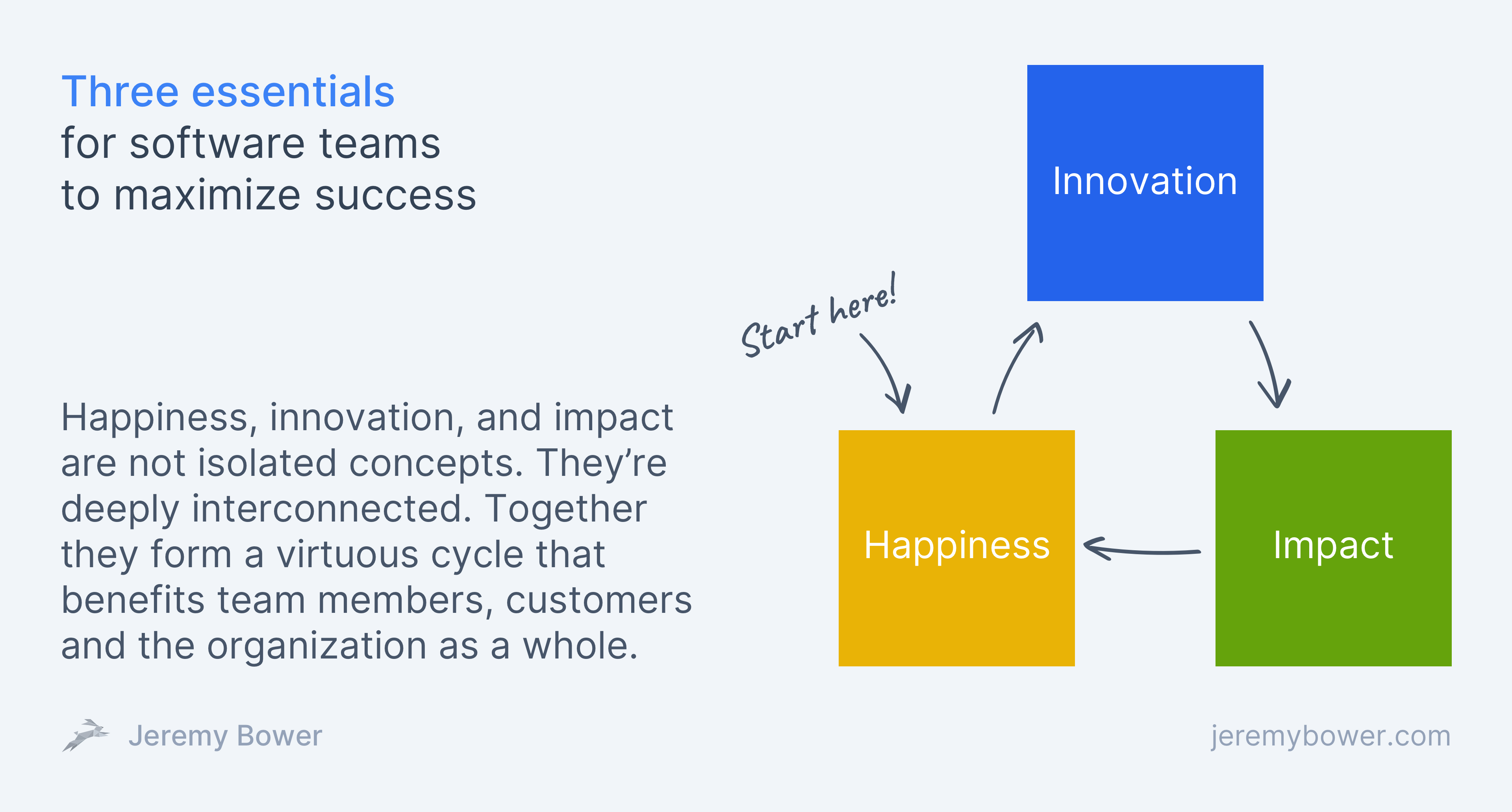
Three Essentials for Software Teams

With all the layoffs in the last year, we can be forgiven for rolling our eyes at a newsletter about happiness, innovation and impact. A lot of talented people have been affected. It's not a particularly happy time. The remaining team members, managers and directors also aren't happy about seeing their colleagues affected by layoffs.
For those of us who lead software organizations, we see the challenges. Goals haven't changed. There is the same amount of work to be done. Only now there are fewer people to do that work, trust is shaken and team morale is down.
To maximize the chances of success for software teams, it's important to focus on what's essential: happiness, innovation and impact.
Start with happiness
A study by the Queen's School of Business and Gallup found that disengaged workers had 37% higher absenteeism and 60% more errors and defects than engaged employees.
Another study at a British telecommunications firm by Oxford University's Saïd Business School found that happy workers were 13% more productive. Some studies have seen productivity climb as high as 20% for happier workers.
Everything else being equal, a happier organization with engaged team members who make fewer errors and are more productive will out-perform the competition.
Build a virtuous cycle
For software teams, happiness, innovation, and impact are deeply interconnected. Each plays a crucial role in the team's success.

Here's how they relate to each other:
- Happiness is a catalyst for innovation: Happy software teams tend to be more creative and open to exploring new ideas. A positive environment encourages team members to think outside the box, take calculated risks, and embrace challenges with a constructive attitude. This heightened level of engagement and satisfaction fuels innovation, as team members are more likely to invest their best efforts to develop novel solutions and improve processes.
- Innovation drives impact: Innovation — through new products, feature enhancements, or process improvements — has a direct, positive impact on customers. It can create competitive advantages, open new markets, improve customer satisfaction, and increase efficiency. These outcomes create value for customers while enhancing the organization's reputation and market position.
- Impact reinforces happiness: When innovation leads to positive outcomes for customers, it creates a feedback loop that reinforces happiness. Customer success boosts morale and create a feeling of satisfaction. This sense of achievement further enhances the happiness of team members, which fosters a positive team culture.
Happiness, innovation, and impact are not isolated concepts. They're deeply interconnected. Together they form a virtuous cycle that benefits team members, customers and the organization as a whole.
A happy and engaged team is more likely to innovate, innovation is critical to create significant business impact, and significant business impact creates a sense of satisfaction that boosts happiness. It's cyclical.
Take action
Here are a few ways to start the happiness, innovation and impact cycle:
- Achievable number of goals / OKRs: Between 1 and 4 throughout the year is about right. Roughly 1 per quarter. Some might take multiple quarters to achieve. More than that and teams can't make meaningful progress on important objectives. A lack of progress prevents the virtuous cycle from starting.
- Show progress: Pick two metrics: a north star metric that tracks value delivered to customers and a KPI that tracks value captured by the organization. For example, monthly active users and revenue. Instead of the number of tasks completed, show teams value delivered and captured over time to build a sense of accomplishment.
- Validate ideas: Most ideas to achieve goals / objectives aren't very good. Even at big tech companies, the success rate of ideas is surprisingly low. At best 30% and typically only 10%. Before committing to implement a solution, gather evidence to support opinions. Evidence not only improves the overall chances of success, but being able to demonstrate a high-level of confidence in the idea motivates teams — which improves chances of success even more.
- Work in small batches: Agile teams do much better with small tasks than large ones. Stack a lot of small wins over time to drive impact and happiness.
- Automate workflows: Remove tedious tasks to make time for impactful work. Automated tests and deployments reduce defects, improve reliability and increase velocity. AI tools can accelerate many common tasks — even coding. When teams can deliver value to customers quickly, impact and happiness go up.
- Create space for creativity: Creativity is the frontend of innovation. Just like we validate product ideas to find the few good ones, we must also validate ideas for novel technical solutions. Give teams a moderate innovation budget (time or money) to validate and implement their ideas. Beyond the satisfaction that teams get from seeing their innovations positively impact customers, the opportunity to explore new ideas itself has a direct and immediate impact on happiness.